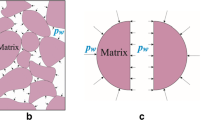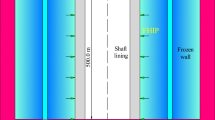Abstract
For one-dimensional soil freezing process, a separate-ice frost heave model is established, and the coupled process of heat transfer, fluid flow and stress development is considered in the model. First, a coupled heat–fluid–stress model describing the growth of a single ice lens is developed by extending the coupled heat–fluid model presented by Zhou and Zhou (Can Geotech J 49(6):686–693, 2012). Second, the mechanism for the formation of a new ice lens in the frozen fringe is studied, and we indicate that if the total vertical disjoining pressure at certain place exceeds the sum of the external pressure and the critical pressure, a new ice lens will emerge. By combining the growth model of a single ice lens and the criterion for the formation of a new ice lens, the separate-ice frost heave model is then established. The difference between the separate-ice model and the rigid-ice model is explained, and the relations for different mathematical models which describe the soil freezing process are also discussed. Numerical analysis of the separate-ice model is conducted using the finite volume method. The freezing tests for Devon silt under no external pressure and Xuzhou silty clay under a constant external pressure are applied to verify the computational results. The consistence between the calculation and the observation validates the separate-ice frost heave model.













Similar content being viewed by others
References
Azmatch TF, Sego DC, Arenson LU, Biggar KW (2012) New ice lens initiation condition for frost heave in fine-grained soils. Cold Reg Sci Technol 82:8–13
Black PB, Tice AR (1989) Comparison of soil freezing curve and soil water curve data for Windsor sandy loam. Water Resour Res 25(10):2205–2210
Bronfenbrener L (2009) The modelling of the freezing process in fine-grained porous media: application to the frost heave estimation. Cold Reg Sci Technol 56:120–134
Cao HZ, Liu S, Jiang F, Liu J (2007) The theoretical study on frost heave for saturated granular soil-numerical simulation of 1-D ice segregating model based on equilibrium of force and phase. Chin J Theor Appl Mech 39(6):848–857 (in Chinese)
Derjacuin BV, Churaev NV (1978) On the question of determining the concept of disjoining pressure and its role in the equilibrium and flow of thin films. J Colloid Interface Sci 66(3):389–398
Fremond M, Mikkola M (1991) Thermomechanical modeling of freezing soil. Ground Freez 91:17–24
Gilpin RR (1979) A model of the “liquid-like” layer between ice and a substrate with applications to wire regelation and particle migration. J Colloid Interface Sci 68(2):235–251
Gilpin RR (1980) A model for the prediction of ice lensing and frost heave in soils. Water Resour Res 16:918–930
Gilpin RR (1980) Theoretical studies of particle engulfment. J Colloid Interface Sci 74(1):44–63
Harlan RL (1973) Analysis of coupled heat–fluid transport in partially frozen soil. Water Resour Res 9(5):1314–1323
Hu K (2011) Development of the separate-ice frost heave model for the soil freezing process. Ph.D. thesis. China University of Mining and Technology, Xuzhou, China (in Chinese)
Konard JM (1988) Influence of freezing mode on frost heave characteristics. Cold Reg Sci Technol 15:161–175
Konard JM, Duquennoi C (1993) A model for water transport and ice lensing in freezing soils. Water Resour Res 29:3109–3123
Konard JM, Morgenstern NR (1980) A mechanistic theory of ice lens formation in fine-grained soils. Can Geotech J 17:473–486
Li HS, Liu ZL, Liang CJ (2001) Mathematical model for coupled moisture, heat and stress field and numerical simulation of frozen soil. Chin J Theor Appl Mech 33(5):621–629 (in Chinese)
Mageau DW, Morgenstern NR (1980) Observations on moisture migration in frozen soils. Can Geotech J 17:54–60
Miao TD, Guo L, Niu YH, Zhang CQ (1999) Modeling on coupled heat and moisture transfer in freezing soil using mixture theory. Sci China (Ser D) 29:8–14 (in Chinese)
Michalowski RL (1993) A constitutive model of saturated soils for frost heave simulations. Cold Reg Sci Technol 22:47–63
Michalowski RL, Zhu M (2006) Frost heave modeling using porosity rate function. Int J Numer Anal Methods Geomech 30:703–722
Miller RD (1978) Frost heaving in non-colloidal soils. In: Proceedings of 3rd international conference on permafrost, Ottawa, 708–713
Nixon JF (1991) Discrete ice lens theory for frost heave in soils. Can Geotech J 28:843–859
O’Neill K, Miller RD (1985) Exploration of a rigid ice model of frost heave. Water Resour Res 21(3):281–296
Patankar SV (1989) Numerical heat transfer and fluid flow. McGraw-Hill, New York
Shen M, Ladanyi B (1987) Modelling of coupled heat, moisture and stress field in freezing soil. Cold Reg Sci Technol 14:237–246
Talamucci F (2003) Freezing process in porous media: formation of ice lenses, swelling of the soil. J Math Comput Model 37:595–602
Tarnawski VR, Wagner B (1996) On the prediction of hydraulic conductivity of frozen soils. Can Geotech J 31:176–180
Xiao ZA, Lai YM, Zhang MY (2017) Study on the freezing temperature of saline soil. Acta Geotech. doi:10.1007/s11440-017-0538-0
Xu XZ, Wang JC, Zhang LX (2001) Physics of frozen soil. Science Press, Beijing (in Chinese)
Zhou Y (2009) Study of frost heave model and frost heave control of frozen soils. Ph.D. Thesis. China University of Mining and Technology, Xuzhou, China (in Chinese)
Zhou MM, Meschke G (2017) A multiscale homogenization model for strength predictions of fully and partially frozen soils. Acta Geotech. doi:10.1007/s11440-017-0538-0
Zhou Y, Xia LJ (2015) Exact solution for Stefan problem with general power-type latent heat using Kummer function. Int J Heat Mass Transf 84:114–118
Zhou Y, Zhou GQ (2010) Numerical simulation of coupled heat–fluid transport in freezing soils using finite volume method. Heat Mass Transf 46:989–998
Zhou Y, Zhou GQ (2012) Intermittent freezing mode to reduce frost heave in freezing soils—experiments and mechanism analysis. Can Geotech J 49(6):686–693
Zhou Y, Wang YJ, Bu WK (2014) Exact solution for a Stefan problem with latent heat a power function of position. Int J Heat Mass Transf 69:451–454
Zhou GQ, Hu K, Zhao XD, Wang JZ, Liang HC, Lu GL (2015) Laboratory investigation on tensile strength characteristics of warm frozen soils. Cold Reg Sci Technol 109:43–52
Acknowledgements
This research was supported by National Key Basic Research Program of China (Grant No. 2012CB026103), National Natural Science Foundation of China (Grant Nos. 41271096, 51204164), 111 Project (B14021) and Jiangsu Overseas Research & Training Program for University Prominent Young & Middle-aged Teachers and Presidents of China. Special thanks to the anonymous reviewers for their comments which have helped to improve this paper greatly.
Author information
Authors and Affiliations
Corresponding author
Rights and permissions
About this article
Cite this article
Zhou, Gq., Zhou, Y., Hu, K. et al. Separate-ice frost heave model for one-dimensional soil freezing process. Acta Geotech. 13, 207–217 (2018). https://doi.org/10.1007/s11440-017-0579-4
Received:
Accepted:
Published:
Issue Date:
DOI: https://doi.org/10.1007/s11440-017-0579-4




